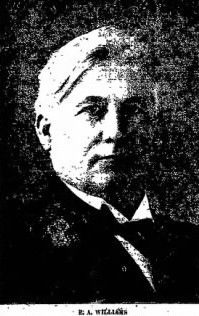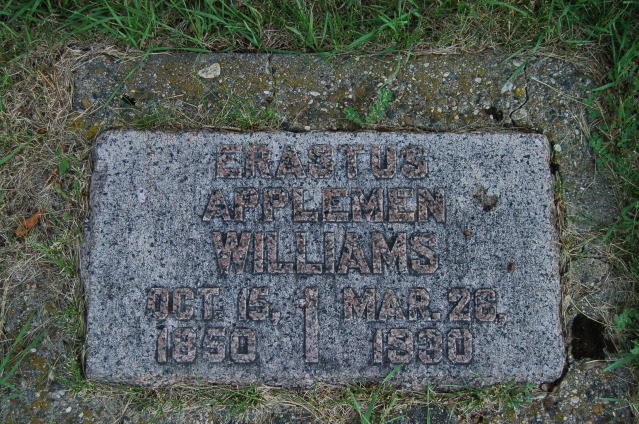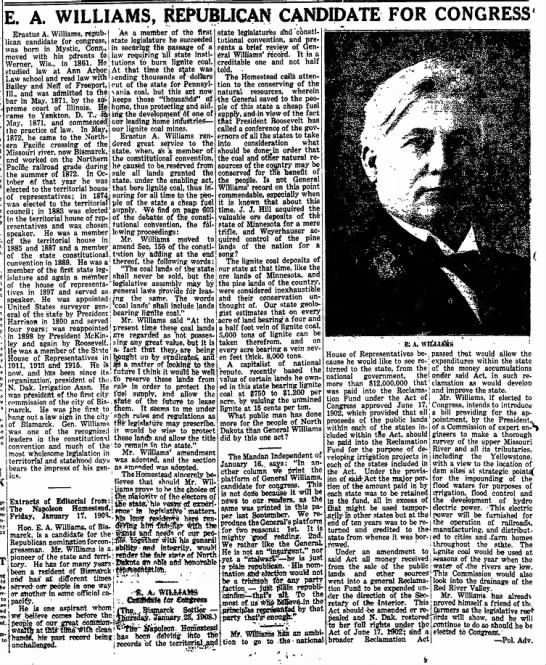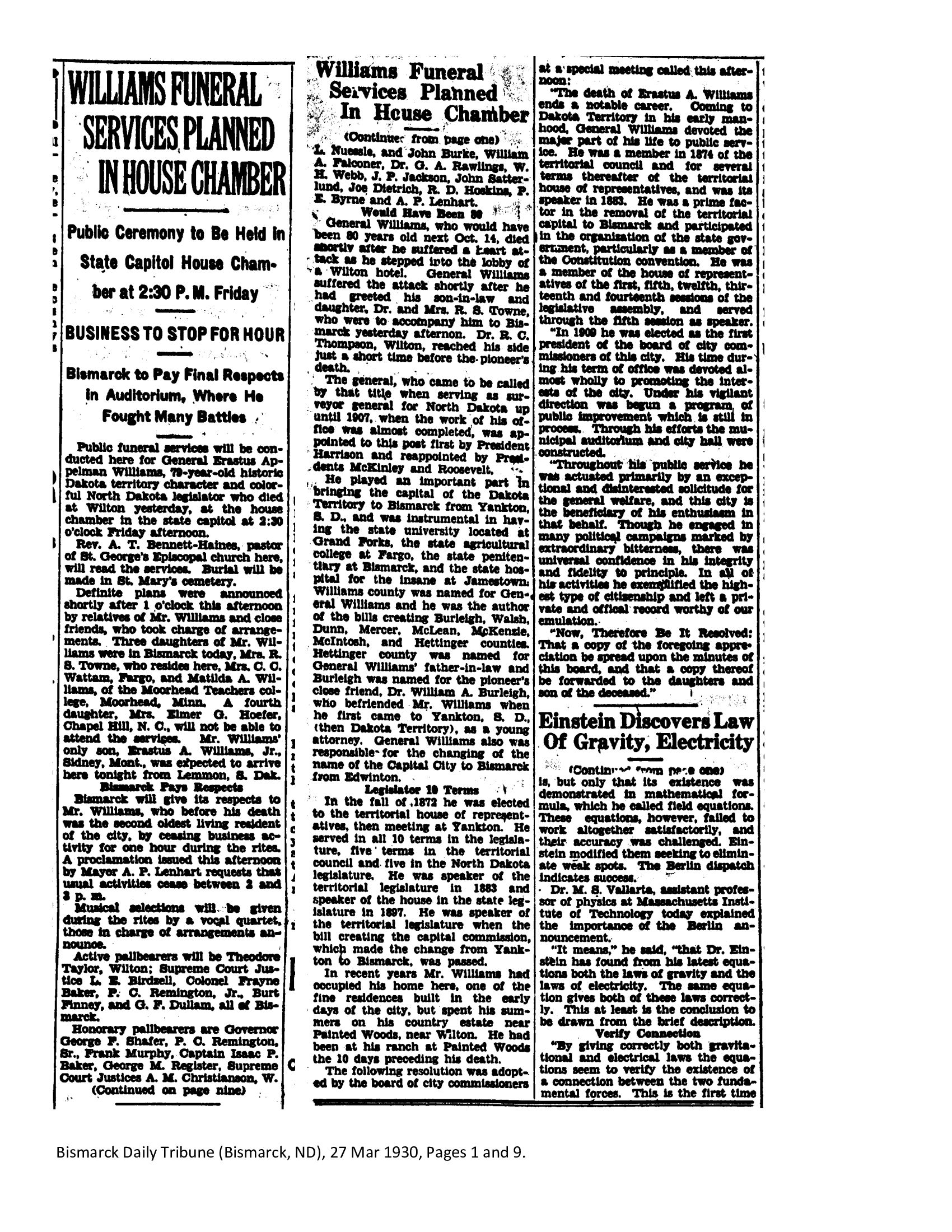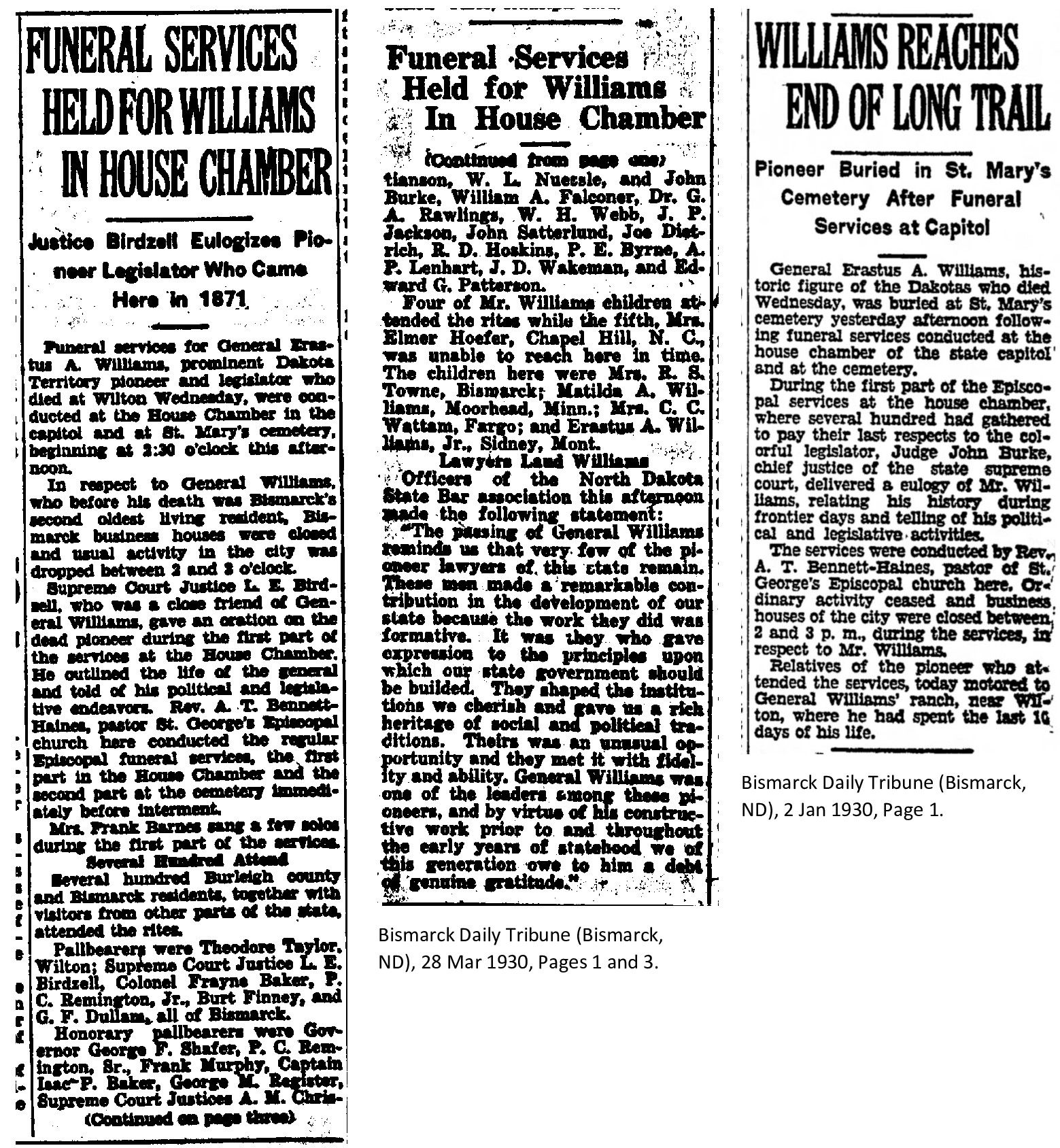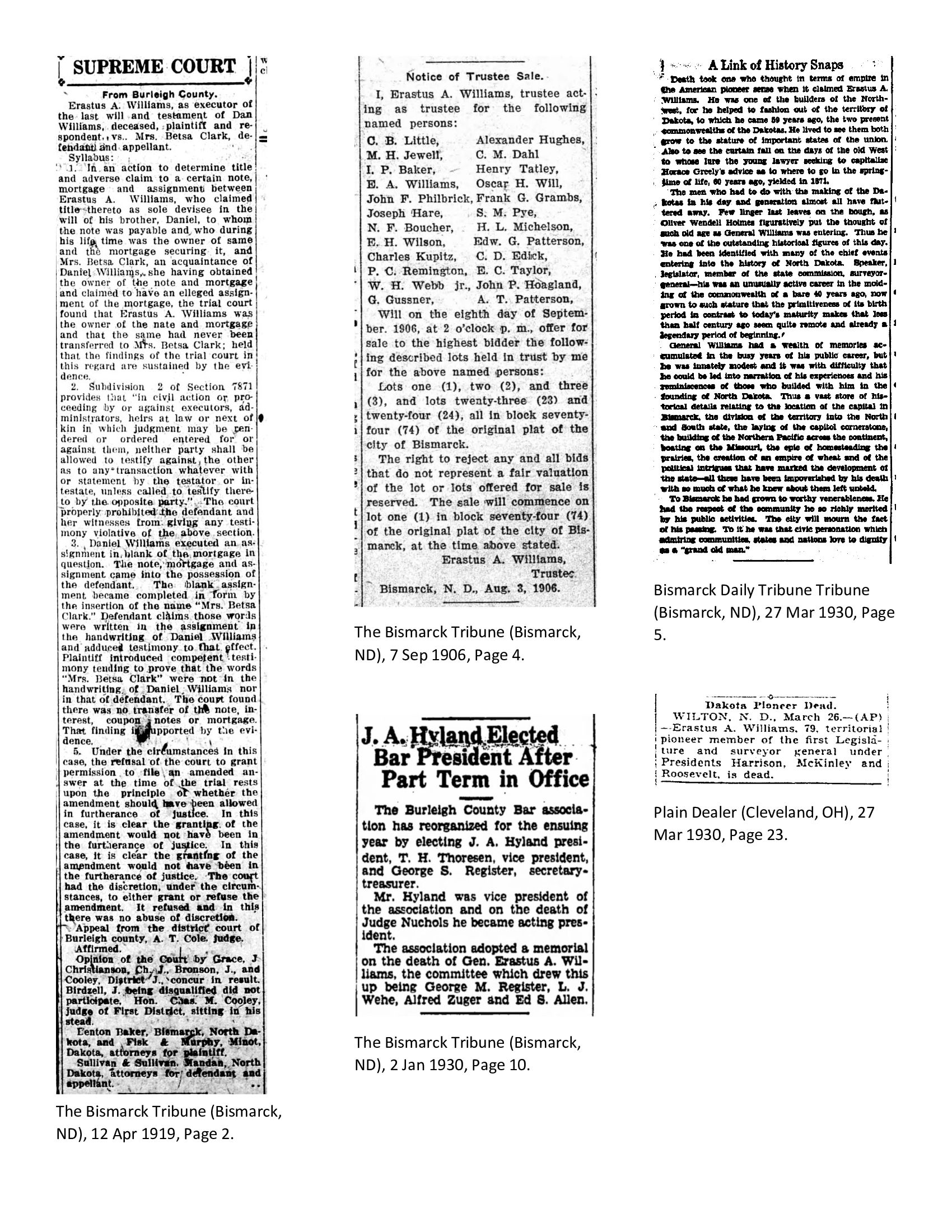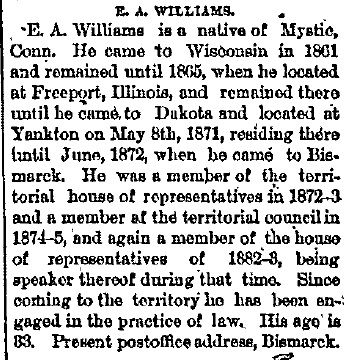BISMARCK’S SECOND OLDEST RESIDENT IS STRICKEN IN WILTON
E. A. Williams today reached the end of the pioneer’s trail.
In a Wilton hotel at 12:45 p.m., Bismarck’s second oldest resident suffered a fatal heart attack as his son-in-law and daughter, Dr. and Mrs. R. S. Towne of Bismarck, met him.
“General” Williams had just come in from his ranch near Painted Creek. Hale and hearty he exchanged greetings with friends as he walked into the hotel lobby and suddenly collapsed.
When Dr. R. C. Thompson, Wilton physician, reached his side, General Williams was breathing his last.
No funeral services have been arranged for the man who played so prominent a part in the exploring, pioneering and developing of the Dakotas.
In the death of General Williams, Bismarck and the northwest, particularly the historic territory bordering the Missouri river, has lost a man whose own life story was a history of his chosen land.
Like other adventurers into the Land of the Dacotahs that was to become an empire, he played not only a part in its beginning but in its evolution, even unto death.
For the past 10 days he had been supervising the affairs of his frontier ranch at Painted Woods. While he had suffered two severe heart attacks during the winter, he did not let the ever present danger deter the pioneer spirit from trying to build better than he had before.
It was this spirit that probably caused him to overexert himself and the heart that had carried him through many pioneer tasks finally succumbed.
There was an unbound and unprinted history of tis state in the memory of General Williams, who earned his reputation by serving North Dakota efficiently many years in the position of United States surveyor general. Because of this work he came to be known familiarly as the “General.”
Before North Dakota was a state he was a resident of what later became the city of Bismarck. Bismarck was the village of Edwinton in 1872.
Burleigh county was named, at the instance of General Williams, for Dr. William A. Burleigh, appointed by Abraham Lincoln as Indian agent at Yankton. Dr. Burleigh gave Williams a key to his office, in which the General practiced law for the first time, and refused to charge rent. General Williams proposed that the county be named for Dr. Burleigh when he was a member of the Territorial legislature in 1872-73.
Mr. Williams decided to move from Yankton to Bismarck when he read in a St. Paul newspaper, in the winter of 1871, that the contract for construction of the Northern Pacific railroad from a point 50 miles east of the Missouri river to what is now Bismarck had been let to his friend, Dr. Burleigh, and Dr. Keith, a Minneapolis man. He thought that Yankton never would have a transcontinental railroad and wanted to locate on one.
General Williams in his early days assisted in the prosecution of several murder cases, the most notable among them being against: Anabal Gallineaus, a French squaw man who shot Alexander Buchel at Pease’s Island and was sentenced to nine years in the Detroit reformatory; a man named Griffin who shot and killed Charles Rider at Painted Woods; and Private Duffy, who murdered Pendered, a bandmaster at Fort Sully.
Mr. Williams played a great part in moving the territorial capital to Bismarck, establishing the state university at Grand Forks, the state agricultural college at Fargo, the penitentiary at Bismarck, and the state hospital for the insane at Jamestown.
He modestly disclaimed credit for himself, however. He admitted he was one of the actors in the little drama which meant so much to the future history of North Dakota, but he declared that history has never given credit where credit is due. George H. Walsh, Grand Forks, Williams once said, was responsible for his election to the speakership of the territorial legislature and establishment of the university at Grand Forks.
The question of removal of the capital came up at the 1882 session of the legislature at Yankton. The U. S. government appropriated $200,000 for the legislative expenses. This money was absorbed biannually at Yankton,
Bills for the establishment of Burleigh, Dunn, Mercer, McLean, McKenzie, McIntosh, and Hettinger counties were put through by Mr. Williams. Hettinger county was named in honor of Mathias Hettinger, the father of the wife of Mr. Williams.
Erastus Appelman Williams was born in Mystic, Conn., Oct 14, 1850, the son of Daniel R. and Matilda Appelman Williams. He received his education in the public schools, but this was limited. He worked about lumber mills and read a great deal with a view to educating himself for the bar. His youth was spent in Connecticut, Illinois, Wisconsin, and it was in the latter state that he was admitted to the practice of law.
He was 21 years old when he came into the Dakota Territory, settling at Yankton. The following year, in 1872, he came to the point which is now Bismarck with the contractors, Burleigh and Keith. He was elected to the territorial legislature in the same year.
He was married to Miss Jennie Hettinger at Freeport, Ill., Feb. 19, 1882. He leaves five children: Mrs. Elmer Hoefer, Chapel Hill, N. C.; Matilda A. Williams of the Moorhead Teachers college, Moorhead, Minn.; Mrs. R. S. Towne, Bismarck: Mrs. C. C. Wattam, Fargo; and Erastus A. Jr., Montana.
Mr. Williams was a member of the Presbyterian church and was a Mason and Knight Templar.
**The Bismarck Tribune, Wednesday, March 26, 1930, pages 1 & 9.
The article has more information on his career accomplishments than I have included here.
BISMARCK’S SECOND OLDEST RESIDENT IS STRICKEN IN WILTON
E. A. Williams today reached the end of the pioneer’s trail.
In a Wilton hotel at 12:45 p.m., Bismarck’s second oldest resident suffered a fatal heart attack as his son-in-law and daughter, Dr. and Mrs. R. S. Towne of Bismarck, met him.
“General” Williams had just come in from his ranch near Painted Creek. Hale and hearty he exchanged greetings with friends as he walked into the hotel lobby and suddenly collapsed.
When Dr. R. C. Thompson, Wilton physician, reached his side, General Williams was breathing his last.
No funeral services have been arranged for the man who played so prominent a part in the exploring, pioneering and developing of the Dakotas.
In the death of General Williams, Bismarck and the northwest, particularly the historic territory bordering the Missouri river, has lost a man whose own life story was a history of his chosen land.
Like other adventurers into the Land of the Dacotahs that was to become an empire, he played not only a part in its beginning but in its evolution, even unto death.
For the past 10 days he had been supervising the affairs of his frontier ranch at Painted Woods. While he had suffered two severe heart attacks during the winter, he did not let the ever present danger deter the pioneer spirit from trying to build better than he had before.
It was this spirit that probably caused him to overexert himself and the heart that had carried him through many pioneer tasks finally succumbed.
There was an unbound and unprinted history of tis state in the memory of General Williams, who earned his reputation by serving North Dakota efficiently many years in the position of United States surveyor general. Because of this work he came to be known familiarly as the “General.”
Before North Dakota was a state he was a resident of what later became the city of Bismarck. Bismarck was the village of Edwinton in 1872.
Burleigh county was named, at the instance of General Williams, for Dr. William A. Burleigh, appointed by Abraham Lincoln as Indian agent at Yankton. Dr. Burleigh gave Williams a key to his office, in which the General practiced law for the first time, and refused to charge rent. General Williams proposed that the county be named for Dr. Burleigh when he was a member of the Territorial legislature in 1872-73.
Mr. Williams decided to move from Yankton to Bismarck when he read in a St. Paul newspaper, in the winter of 1871, that the contract for construction of the Northern Pacific railroad from a point 50 miles east of the Missouri river to what is now Bismarck had been let to his friend, Dr. Burleigh, and Dr. Keith, a Minneapolis man. He thought that Yankton never would have a transcontinental railroad and wanted to locate on one.
General Williams in his early days assisted in the prosecution of several murder cases, the most notable among them being against: Anabal Gallineaus, a French squaw man who shot Alexander Buchel at Pease’s Island and was sentenced to nine years in the Detroit reformatory; a man named Griffin who shot and killed Charles Rider at Painted Woods; and Private Duffy, who murdered Pendered, a bandmaster at Fort Sully.
Mr. Williams played a great part in moving the territorial capital to Bismarck, establishing the state university at Grand Forks, the state agricultural college at Fargo, the penitentiary at Bismarck, and the state hospital for the insane at Jamestown.
He modestly disclaimed credit for himself, however. He admitted he was one of the actors in the little drama which meant so much to the future history of North Dakota, but he declared that history has never given credit where credit is due. George H. Walsh, Grand Forks, Williams once said, was responsible for his election to the speakership of the territorial legislature and establishment of the university at Grand Forks.
The question of removal of the capital came up at the 1882 session of the legislature at Yankton. The U. S. government appropriated $200,000 for the legislative expenses. This money was absorbed biannually at Yankton,
Bills for the establishment of Burleigh, Dunn, Mercer, McLean, McKenzie, McIntosh, and Hettinger counties were put through by Mr. Williams. Hettinger county was named in honor of Mathias Hettinger, the father of the wife of Mr. Williams.
Erastus Appelman Williams was born in Mystic, Conn., Oct 14, 1850, the son of Daniel R. and Matilda Appelman Williams. He received his education in the public schools, but this was limited. He worked about lumber mills and read a great deal with a view to educating himself for the bar. His youth was spent in Connecticut, Illinois, Wisconsin, and it was in the latter state that he was admitted to the practice of law.
He was 21 years old when he came into the Dakota Territory, settling at Yankton. The following year, in 1872, he came to the point which is now Bismarck with the contractors, Burleigh and Keith. He was elected to the territorial legislature in the same year.
He was married to Miss Jennie Hettinger at Freeport, Ill., Feb. 19, 1882. He leaves five children: Mrs. Elmer Hoefer, Chapel Hill, N. C.; Matilda A. Williams of the Moorhead Teachers college, Moorhead, Minn.; Mrs. R. S. Towne, Bismarck: Mrs. C. C. Wattam, Fargo; and Erastus A. Jr., Montana.
Mr. Williams was a member of the Presbyterian church and was a Mason and Knight Templar.
**The Bismarck Tribune, Wednesday, March 26, 1930, pages 1 & 9.
The article has more information on his career accomplishments than I have included here.
Family Members
Sponsored by Ancestry
Advertisement
Explore more
Sponsored by Ancestry
Advertisement
